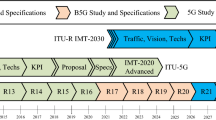Abstract
For serving futuristic applications like distributed robotic systems with robots equipped with humanoid intelligence, wireless access to high-performance computing resources should be provided. For this purpose, a very dense wireless network, referred to as attocell network, consisting of radio cells typically less than 1 m\(^{2}\), and antennas integrated in the floor tiles has been proposed. To serve these small cells, we propose several architectures for the backbone network using radio over fiber-based technology. In addition, we propose a MAC protocol based on simple polling approach to compute the splitting ratio for various cell sizes based on the network load for a delay requirement of 10 \(\upmu \hbox {s}\). We propose an analytical model for the same to validate the results obtained from the simulation. The cost analysis of these architectures is also presented. Based on this, we give some general design recommendations of an attocell network.












Similar content being viewed by others
Notes
Note that the bit rates are proportional to the available bandwidth by Shannon’s theorem.
The delay penalty of registering and identifying the users is not considered.
References
InfiniBand Trade Association: InfiniBand Architecture Specification: Release 1.0. (2000)
Torfs, G., et al.: ATTO-wireless networking at fiber speed. J. Lightw. Technol. 36(8), 1468–1477 (2017)
Rajalakshmi, K., Gopal, K.: A survey on cost effective survivable network design in wireless access network. J. Comput. Sci. Eng. Surv. 5(1), 11–18 (2014)
Lannoo, B. et al.: Radio-over-fibre for ultra-small 5G cells. IEEE International Conference on Transparent Optical Networks (ICTON), Budapest, pp. 1–4 (2015)
Breyne, L., et al.: Comparison between analog radio-over-fiber and sigma delta modulated radio-over-fiber. IEEE Photonics Technol. Lett. 29(21), 1808–1811 (2017)
Das, A., Mjeku, M., Nkansah, A., Gomes, N.J.: Effects on IEEE 802.11 MAC throughput in wireless LAN over fiber systems. J. Lightw. Technol 25(11), 3321–3328 (2007)
Mjeku, M., Gomes, N.J.: Analysis of the request to send/clear to send exchange in WLAN over fiber networks. J. Lightw. Technol. 26(15), 2531–2539 (2008)
Kalfas, G., Pleros, N.: An agile and medium-transparent MAC protocol for 60 GHz radio-over-fiber local access networks. J. Lightw. Technol. 28(16), 2315–2326 (2010)
Singh, K., Dixit, A., Jain, V.K.: Performance analysis of non-converged and converged medium access control protocols for radio-over-fiber networks. In: Twenty-Fourth National Conference on Communications (NCC), Hyderabad, pp. 1–6 (2018)
Dixit, A.: Architectures and algorithms for radio-over-fiber networks. J. Opt. Commun. Netw. 10(5), 535–544 (2018)
Carpintero, G. et al.: Photonic-enabled millimeter-wave wireless data transmission links based on photonic integrated circuits. In: Optical Fiber Communication Conference, Optical Society of America, Los Angeles, pp. 1–3 (2015)
Webpage: https://www.angieslist.com/articles/tile-flooring-choices-descriptions-and-costs.htm
Acknowledgements
This work was supported in part by the Department of Electronics and Information Technology (DeitY), Govt. of India, under the project, “Visvesvaraya Ph.D Scheme for Electronics and IT at IIT Delhi” and by the Department of Science and Technology, SERB project, RP03270.
Author information
Authors and Affiliations
Corresponding author
Additional information
Publisher's Note
Springer Nature remains neutral with regard to jurisdictional claims in published maps and institutional affiliations.
Rights and permissions
About this article
Cite this article
Singh, K., Dixit, A. & Jain, V.K. Optical backbone and control of attocell network. Photon Netw Commun 39, 165–180 (2020). https://doi.org/10.1007/s11107-020-00884-x
Received:
Accepted:
Published:
Issue Date:
DOI: https://doi.org/10.1007/s11107-020-00884-x




